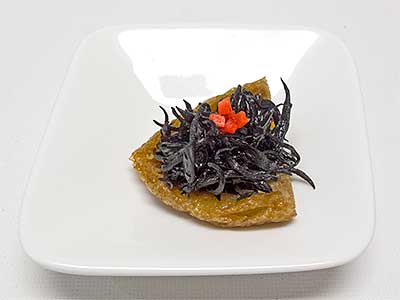March 17, 2014
Amuse-Bouche

algues mijoté
(simmered seaweed)
Hijiki is really a neat sounding word! The Latin equivalent Sargassum fusiforme is not so much fun. Both names refer to a brown sea vegetable harvested on the coasts of Japan, Korea, and China. By the time I purchase it in its dried form, it resembles small, black twigs. Even after rehydration, it doesn’t look particularly appetizing. I love it nonetheless.
When I cook hijiki, I’ll usually add strips of aburage, deep-fried tofu, to the preparation. For this amuse-bouche, I decided to turn the dish a bit inside-out and wrap the hijiki in the aburage. Rather than leaving the aburage plain, I cooked it in a sweet sauce as would be done before using it to enclose rice for inari sushi.
The finished amuse-bouche is the coming together of two very separate preparations: hijiki and aburage. The hijiki preparation, is adapted from a recipe I found on page 77 of Hiroko Urakami’s Japanese Family-Style Recipes. This recipe produces 6 to 8 portions.
4 g (0.14 oz)
dried hijiki
1⁄2 T
Japanese soy sauce
1⁄2 T
mirin
1⁄2 T
granulated sugar
60 ml (1⁄4 c)
water
1. Soak hijiki in tap water for 30 minutes. Drain well.
2. Combine the rehydrated hijiki with the remaining ingredients in a small saucepan. Simmer the combination until most of the liquid has evaporated and what remains is thickened. This takes about 15 minutes.
3. Set aside to cool.
Note: The cooked hijiki lasts for quite a few days in a tightly covered container in the refrigerator.
The abruage preparation is adapted from a recipe I found on page 130 of a book titled Itadakimasu, an undated, self-published book from the Dana Group of the Gardena (California) Buddhist Church. The major ingredient, the aburage is purchased a few to the package. Prepared aburage is also available, but I prefer to do it myself. Depending on the shape, either the ends or the corners go into this recipe. The ends produce two portions, and the corners produce single portions. The following recipe produces 12 servings.
6 ends or 12 corners
aburage
120 ml (1⁄2 c)
dashi
1⁄2 T
Japanese soy sauce
1-1⁄2 T
granulated sugar
1. Boil the aburage in water for 15 minutes. Use a drop-lid (otoshi buta) to keep the aburage immersed in the boiling water. When done, drain, rinse with cold water, and blot dry with absorbent paper.
2. Slowly simmer the boiled aburage in the dashi, soy sauce, and sugar until the sauce is absorbed and the pan is almost dry. Remove the aburage to a plate. Cool completely. Blot dry with absorbent paper.
Note: The cooked aburage lasts for quite a while in the refrigerator if tightly wrapped.
To present the amuse-bouche, if using aburage ends, cut each in half to make a corner. Form each aburage corner into a little cup and fill with the hijiki. Decorate the hijiki with a little diced, red, pickled ginger (beni shoga).
© 2014 Peter Hertzmann. All rights reserved.
